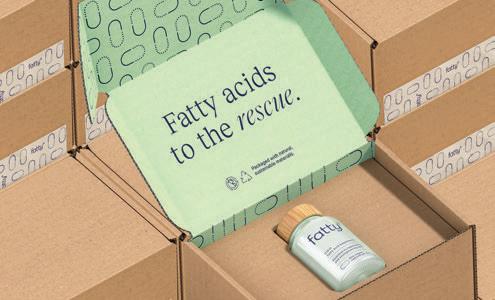
14 minute read
E-COMMERCE/SUSTAINABILITY
The inside of the corrugated shipper is laminated with a printed top sheet that conveys the upbeat, quippy brand messaging. Stacked shippers illustrate how little space is wasted in this packaging system.
Subscription D2C Supplement Brand Makes Sustainable Impression at Unboxing
MATT REYNOLDS, EDITOR, PACKAGING WORLD
1. With an underwater origin story, a new-toscience fatty acid nutraceutical is designed to improve longevity. 2. Seraphina Therapeutics created a sustainability-minded D2C packaging and unboxing experience. 3. An impressive starter kit is followed by sleek, pared down refi ll mailers, complete with water-activated tape.
TOP THREE TAKEAWAYS
The founders of nutraceutical company Seraphina Therapeutics, producer of the new Fatty 15 essential fatty acid supplement, come with an origin story that’s fi t for a Bond movie. Dr. Stephanie Venn-Watson, the CEO, is a veterinary epidemiologist with a host of degrees and credentials across disciplines. Dr. Eric Venn-Watson, her husband and COO, is a Navy physician that spent years internationally deployed as a military orthopedic surgeon and aerospace medicine specialist before entering the private sector. Recently, the two have been featured in publications like Forbes, Authority, and Worth as examples of an entrepreneurial power couple.
But here’s a wrinkle that could be straight from a comic book: the Seraphina pair discovered their fi rst product—a new-to-science variety of healthful fatty acid—by working on a long-standing project studying Navy-raised and -trained dolphins. The discovery was corroborated with the aid of 60 years’ worth of Navy-collected
experimental dolphin data and cell samples. You read that correctly, military dolphins.
More specifically, the discovery is of a trace fatty acid called C15:0, eventually to be branded as Fatty 15, that Seraphina says has evidence of significantly promoting cellular resilience and general health. The company claims this fatty acid boosts human longevity by strengthening cell membranes, supporting mitochondria, and activating receptors in our bodies that regulate metabolism, immunity, mood, sleep, and appetite.
I’ll have to take their word for it, but the discovery was impressive enough for lauded scientific journal Nature to publish Venn-Watsons’ findings. Luckily, Fatty 15’s packaging origin story is a good one as well. The C15:0 ingredient itself spent more than a decade in research and development. But as promising as it appeared to science and academia, Seraphina knew that C15:0 wasn’t going to sell itself to consumers.
“It’s our intellectual property, we’ve published on it, and we now have 28 patents on this technology, nine of which are issued,” says Eric Venn-Watson. “We finally had to ask ourselves how would we bring this discovery to the masses? How could we improve global health? More practically, we asked ourselves how we would manufacture this. And what kind of packaging would we need?”
More freedom in packaging
There are regulatory guidelines on safely getting the ingredient into a capsule and safely getting the capsules into a package to protect it. Once those capsules are safely sealed in a suitable pack, they can be packed in non-food-contact secondary packaging, which affords the brand a lot more freedom for artistry and latitude for brand positioning. (Considering its target market of health- and sustainability-minded Millennials and Gen Xers, Seraphina also must certify that the product is both vegan and sustainably sourced.)
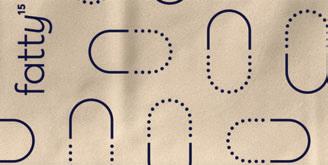
↑ The branded ‘pill pattern’ is used on the tape and various decorative spots on the pack. The design is meant to recall the C15:0 chemical name for Fatty 15.

↑ An exploded view of the Fatty 15 starter kit demonstrates the use of corrugated inserts to safely handle a glass bottle through the many-touchpoints of the e-comm channel in a compact format without extra space or the need for dunnage.
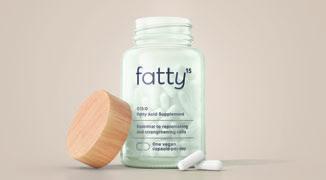
↑ This elegant, silkscreen-printed durable glass bottle with bamboo closure doesn’t need to be hidden away in a medicine cabinet with your other white HDPE pill bottles. It’s designed to be display-worthy.
At the time of the January 2021 launch, C15:0 was (and still is) a Direct to Consumer (D2C) distribution play using the Shopify D2C logistics software platform. This e-comm-based go-to-market format meant consumers’ first physical interaction with the brand would be by way of a shipper arriving on their doorstep. To maximize its impact at this critical point, the company enlisted L.A.-based creative and brand design agency Phenomenon (which goes by phno) to work out brand positioning, naming, identity guidelines, and the sourcing and implementation of the packaging. Ali Filsoof, Design Director at phno, led this process.
He was involved in an early, tenor-setting brand decision to move away to the clinical-sounding C15:0 ingredient name to the more engaging Fatty 15. The name plays on the juxtaposition between consumers’ historical vilification of fats and the fact that certain fats, like C15:0, are required for life (putting the “essential” in essential fatty acids). The name Fatty 15 is a bold attention getter and conversation starter to the brand’s health-aware target market.
Another branded design element that would end up being reused across the packaging is a “pill pattern” graphic depicting alternatingly oriented horizontal and vertical capsules. One half of each capsule is represented by an unbroken “C” shaped line, the other half consists of 15 dots outlining the same, but inverse “C” shape. The design is meant to recall consumers to the C15:0 chemical name.
As Filsoof’s brand strategies and designs began to crystalize, he brought in Erin Moharita, CPP, Principal of boutique packaging agency EKM, to make sure they were on point on the technical and procurement side of packaging. Moharita’s specialty is connecting entrepreneurs—many of whom are unfamiliar with the packaging supply chain or lack enough volume to meet their MOQs—with her extensive network of larger or premium packaging suppliers that
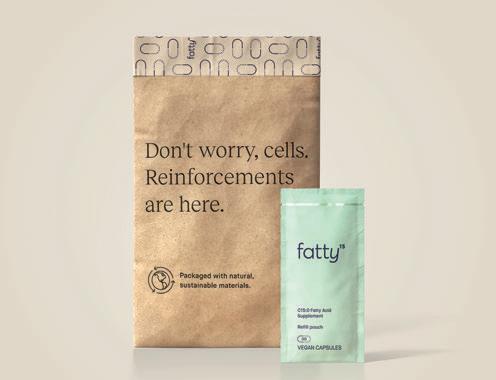
↑ Metallized pouches, with an FSC-certified, printed paper layer exterior, carry the capsules through the supply chain while providing a moisture and oxygen barrier. These pouches easily fit into a small kraft mailer for the subscription-based refills.
might not otherwise engage with smaller, emerging brands.
Balancing sustainability with product protection, shelf life
Health and wellness consumers that are likely to be drawn to Fatty 15 tend to value sustainability and seek to protect the environment. “That’s why one of Seraphina’s early directives on packaging was to be as environmentally friendly as possible. When I think about packaging in general—particularly in e-comm, D2C, and Amazon though they’re working to change things—I think of a box, in a box, in a box, in a box,” Filsoof says. “I challenged the team and myself to practice what I’m calling un-packaging. We’re not putting beautiful graphics on a box that’s bound to go into a plain shipper filled with unnecessary extra material like padding. We thought about what materials we could use that are unconventional but more sustainable. We researched for weeks on what those possibilities could be and then we started designing different packaging options.”
The team arrived at a dual-pronged packaging strategy that consists of a sustainability-minded starter kit shipper, designed to impart a carefully conceived aesthetic during unboxing. The centerpiece of the starter kit is a durable glass bottle designed to contain the product—eventually. The bottle is delivered empty. Also within the starter kit are three metallized film pouches that each contain a month’s worth of Fatty 15 capsules (30).
“The pouch is a laminate foil—we needed that for shelf life, for the capsules to survive the warehouse setting prior to getting to a consumer, and then opening, and then being used,” says Moharita. “We wanted to make sure it had the longest shelf life possible.”
While multi-layer metallized films aren’t recyclable themselves, they accomplish the essential logistical task of getting the product into homes safely, and carry necessary oxygen and moisture barriers. The lightweight pouches have some sustainability pros of their own—the top layer of the lamination is made from post-consumer recycled (PCR) paper that is 100% FSC (Forest Stewardship Council)-Certified. This paper layer is flexographically printed in three colors: white, green, and blue.
Consumers are meant to open the starter kit, open the first three pouches, and fill the durable bottle with the 90 capsules. Thereafter, a quarterly, subscription-based e-comm delivery of three of the same three metallized film pouches incrementally restocks consumers. After the initial starter kit, only a kraft-style flat mailer envelope is needed to deliver the refill pouches. The stakeholders involved
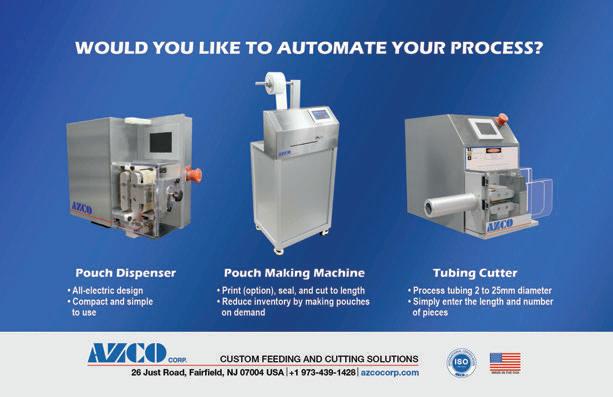
declined to name their packaging suppliers.
Durable glass bottle
If you’ve ever been to a GNC retail location, you know that nutraceuticals and supplement capsules are largely packed in white plastic bottles, often HDPE, adorned with shrink or p-s labels. While these formats can be recycled, they often are sold almost comically underfilled. This also is endemic to OTC pharma capsules. Consider that a 25-pack and a 100-pack of ibuprofen might use the same size of HDPE bottle—it may be simpler for a brand to limit pack formats, but it’s perceived as wasteful. Also, though they tend to carry decoration, these bottles aren’t exactly artistic.
Fatty 15 takes a different tack with an elegant, durable glass bottle meant to be displayed in full view on a bathroom counter instead of hiding in a medicine cabinet. The easily recyclable bottle is sprayed in the brand color specified by Phenomenon, similar to seafoam green, then decorated with simple messaging via silkscreen printing directly on the bottle, one color—dark blue, bordering on black.
Direct decoration on the bottle—which would hold up better than a label in a bathroom setting—needed to be high-quality considering that the bottle would be handled multiple times.
Since the capsules are primarily packaged in metallized foil pouches, all regulatory information and instructions for use need only appear on the pouches. The durable show piece of a bottle is allowed to remain simple and uncluttered.
What really makes the bottle pop is its bamboo closure. A wood closure was originally specified in the design briefs, but there were some problems marrying the bottle threading to the closure. After expanding a closure search, bamboo’s advantages quickly became evident. First, bamboo is a plentiful, fast-growing grass, so the material’s renewability profile is strong. “And from a shipping and environmental standpoint, bamboo is a lot lighter than the wood, so I think in the end it was a better choice,” Moharita says. “I think the wood cap still was a great avenue that we explored, but the end result with the bamboo cap, in my opinion, is better.”
The lone piece of decoration that isn’t directly printed on the bottle and closure combination is a piece of recyclable pressure-sensitive tape. It provides tamper evidence, but also affords a narrow strip of billboard space to reinforce the “pill pattern” design.
The bamboo closure does have an inner polypropylene (PP) fitment to accept the bottle’s thread that is made out of 100% PCR material. “Anywhere we could, we were as environmentally friendly as possible in terms of the material we’re sourcing as well as the lifespan,” Moharita says. “Durability and lifespan of the piece was really important as well.”
Based on estimated sales, the company says that in 2021 alone, the use of a durable glass bottle instead of a typical HDPE pill bottle will save 9.24 tons of plastic.
Fatty 15 uses a shipper made from 100% PCR kraft corrugated, adding a circular quality to what already was recyclable. Instead of printing directly on corrugated, the Fatty 15 team decided to print a top sheet and laminate it to one side, the inside-facing corrugated wall. The top sheet is also recyclable and is made out of FSC-certified paper.
“We didn’t print directly on the kraft since we just felt that the top sheet gave a little bit of a cleaner look. The color was a little more vibrant going down this route, and we just could get better quality. Also, I find that when you print on these top sheets, you’re getting less corrugated ‘dust’ coming from the shipper as it travels through the supply chain. That was really important since we feature a beautifully decorated glass bottle with no carton protecting it,” Moharita says.
A corrugated kraft insert is used to hold the glass bottle in place, and to orient it toward consumers as they unbox the product. This bottle-holding insert rests on a second corrugated insert, this one seamed and erected to be a 3D, shelf-like structure that forms a collar around the inside bottom of the shipper. This corrugated collar cradles three pouches’ worth of capsules, three packs at 30 days each. To maintain a small footprint, the box was custom-designed with only enough room to hold the inserts, while inserts are laser cut to the bottle size to eliminate the need for padding.
As we’ve seen with other successful subscription-based D2C personal care plays (see Grove and Truman’s), text printed on the top sheet is punchy, upbeat, and implies a wink. The design uses infographic-style visual cues and the brand’s “pill pattern” graphic, flexographically printed in two colors, the brand’s green and blue. Of note, the inks used here are vegetable-based, thus more sustainable.
The final top sheet-printed flourish appears on the inside bottom flap, intended to be read as a consumer removes the last of the three pouches of capsules. There, dark blue text on sea green paper reads, “Okay, now you can recycle me,” serving both as a closing remark on the brand’s sustainability profile, and practical reminder to the user.
The company is using a recycled kraft paper, water-activated tape that’s custom printed with the brand name and capsule pattern. What’s particularly interesting about it is that it is fully recyclable while still stuck to the corrugated shipper—no need to remove it, unlike tapes that are reinforced by fiber crosshatching.
“As much as you might not think about tape when you’re looking at the whole package, with the careful branding, beautiful packaging, and everything we designed in the brand, I think that the tape was a really huge win,” Moharita says. “Because of the weights, and how we designed everything in consideration of how these ship, we were able to use this type of unreinforced tape, which is really cool.”
Refill packs
Since the starter kit contains 90 days’ worth of capsules, about three months pass before the next delivery arrives at consumers’ doorsteps. The brand calculated that it’d be favorable for customers to have enough time to really start feeling the positive effects of the supplement before they started the subscription portion of their account.
The next delivery looks nothing like the dramatic starter kit, instead focusing on minimal design and limited packaging usage.
“We’re just using a mailer envelope that is fully recyclable. On top of the mailer envelope, all the printing on there is done with an algae-based ink which is really interesting, it’s kind of a newer product in the industry that’s highly renewable,” Filsoof says. “I started investigating it a little further and we found a vendor. We’re really proud of the mailer as well because it’s as small as it can be to hold the three pouches [90 capsules] and it’s fully recyclable, and the algae ink is unique.”
The PCR padded kraft paper is FSC-certified, features quippy copy, and uses a fiber-based padding that’s also recyclable, unlike bubble mailers. It uses the aforementioned recyclable tape, as well.
What’s next?
The brand is currently looking into other channels, retail and otherwise, that will be able to accommodate their current pack format, and is also considering new packaging formats tailored to the channel. One step—that Eric Venn-Watson thinks might really blow the doors off of this discovery—is FDA recognition as GRAS (Generally Recognized as Safe) categorization for C15:0 as a food additive or food ingredient. This takes the fatty acid outside of the capsule, and into the food ingredient category for healthful foods. “And I think from the Seraphina Therapeutics and Fatty 15 standpoint, and the ingredient FA15, our goal is to just really improve global health. This is important and we want to get this out to people and dolphins,” he says. Wait, dolphins? Bringing the story full circle, Eric adds that, “This supplement’s going to go back to the dolphins as well, to continue to improve their health, which is neat.”
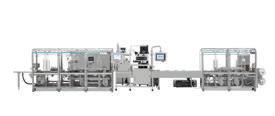
Performance, Packaged
YOUR PACKAGING IS IN SAFE HANDS

Custom designed packaging that’s dependable, secure, and precise.
Ossid is an industry leader supplying reliable equipment to suit your packaging needs
• Ideal for meeting large capacity requirements with up to 30 cycles per minute • Robust framework and guarding package available
8000M








